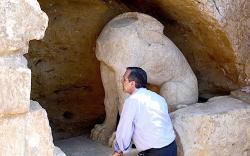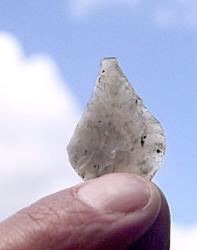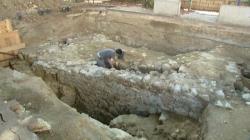INSTITUT SUPERIEUR D'ANTHROPOLOGIE
INSTITUTE OF ANTHROPOLOGY
ONLINE COURSES / COURS A DISTANCE
FALL TERM : OCTOBER 2014
REGISTER NOW
GRECE –  Amphipolis - Archaeologists have unearthed a vast ancient tomb in Greece, distinguished by two sphinxes and frescoed walls and dating to 300-325 B.C., in the country's northeast Macedonian region, the government said on Tuesday. It marks a significant discovery from the early Hellenistic era, although a Culture Ministry official said there was no evidence yet to suggest a link to Alexander the Great, who died in 323 B.C. after an unprecedented military campaign through the Middle East, Asia and northeast Africa, or his family. The official said the Amphipolis site, situated about 100 km (65 miles) northeast of Greece's second-biggest city Thessaloniki, appeared to be the largest ancient tomb to have been discovered in Greece. Archaeologists, who began excavating the site in 2012, expect to enter the tomb by the end of the month to determine out who was buried there. "It looks like the tomb of a prominent Macedonian of that era," said a second culture ministry official, declining to be named. Alexander the Great died in Babylonia, in what is modern Iraq, and his actual burial place is not known. Archaeologists have found two sphinxes, thought to have guarded its entrance, a 4.5-metre-(yard)-wide road leading into it, with walls on both sides covered by frescoes. It is circled by a 497-metre-long marble outer wall. Experts believe a five-meter-tall lion sculpture previously discovered nearby once stood atop the tomb.
Amphipolis - Archaeologists have unearthed a vast ancient tomb in Greece, distinguished by two sphinxes and frescoed walls and dating to 300-325 B.C., in the country's northeast Macedonian region, the government said on Tuesday. It marks a significant discovery from the early Hellenistic era, although a Culture Ministry official said there was no evidence yet to suggest a link to Alexander the Great, who died in 323 B.C. after an unprecedented military campaign through the Middle East, Asia and northeast Africa, or his family. The official said the Amphipolis site, situated about 100 km (65 miles) northeast of Greece's second-biggest city Thessaloniki, appeared to be the largest ancient tomb to have been discovered in Greece. Archaeologists, who began excavating the site in 2012, expect to enter the tomb by the end of the month to determine out who was buried there. "It looks like the tomb of a prominent Macedonian of that era," said a second culture ministry official, declining to be named. Alexander the Great died in Babylonia, in what is modern Iraq, and his actual burial place is not known. Archaeologists have found two sphinxes, thought to have guarded its entrance, a 4.5-metre-(yard)-wide road leading into it, with walls on both sides covered by frescoes. It is circled by a 497-metre-long marble outer wall. Experts believe a five-meter-tall lion sculpture previously discovered nearby once stood atop the tomb.
http://www.reuters.com/article/2014/08/12/us-greece-tomb-idUSKBN0GC19J20140812?rpc=401&feedType=RSS&feedName=lifestyleMolt&rpc=401
ROYAUME UNI –  Caerau - Archaeologists hoping to discover Roman and Iron Age finds at a Welsh hillfort were shocked to unearth pottery and arrowheads predating their predicted finds by 4,000 years at the home of a powerful Iron Age community, including flint tools and weapons from 3,600 BC.Caerau, an Iron Age residency on the outskirts of Cardiff, would have been a battleground more than 5,000 years ago according to the arrowheads, awls, scrapers and polished stone axe fragments found during the surprising excavation.“Quite frankly, we were amazed,” says Dr Dave Wyatt, the co-director of the dig, from Cardiff University. “Nobody predicted this. Our previous excavation [in 2013] yielded pottery and a mass of finds, including five large roundhouses, showing Iron Age occupation, and there’s evidence of Roman and medieval activity.“But no-one realised the site had been occupied as far back as the Neolithic – predating the construction of the Iron Age hillfort by several thousand years.”Oliver Davis, Dr Wyatt’s colleague on the CAER project, says the ditches date from the early Neolithic period when communities first settled and farmed the landscape.“The location and number of Neolithic finds indicate that we have discovered a causewayed enclosure – a special place where small communities gathered together at certain important times of the year to celebrate, feast, exchange things and possibly find marriage partners,” he believes.“Such sites are very rare in Wales with only five other known examples, mostly situated in the south.“What's fascinating is that a number of the flint arrowheads we have found have been broken as a result of impact - this suggests some form of conflict occurred at this meeting place over 5,000 years ago.”
Caerau - Archaeologists hoping to discover Roman and Iron Age finds at a Welsh hillfort were shocked to unearth pottery and arrowheads predating their predicted finds by 4,000 years at the home of a powerful Iron Age community, including flint tools and weapons from 3,600 BC.Caerau, an Iron Age residency on the outskirts of Cardiff, would have been a battleground more than 5,000 years ago according to the arrowheads, awls, scrapers and polished stone axe fragments found during the surprising excavation.“Quite frankly, we were amazed,” says Dr Dave Wyatt, the co-director of the dig, from Cardiff University. “Nobody predicted this. Our previous excavation [in 2013] yielded pottery and a mass of finds, including five large roundhouses, showing Iron Age occupation, and there’s evidence of Roman and medieval activity.“But no-one realised the site had been occupied as far back as the Neolithic – predating the construction of the Iron Age hillfort by several thousand years.”Oliver Davis, Dr Wyatt’s colleague on the CAER project, says the ditches date from the early Neolithic period when communities first settled and farmed the landscape.“The location and number of Neolithic finds indicate that we have discovered a causewayed enclosure – a special place where small communities gathered together at certain important times of the year to celebrate, feast, exchange things and possibly find marriage partners,” he believes.“Such sites are very rare in Wales with only five other known examples, mostly situated in the south.“What's fascinating is that a number of the flint arrowheads we have found have been broken as a result of impact - this suggests some form of conflict occurred at this meeting place over 5,000 years ago.”
http://www.culture24.org.uk/history-and-heritage/archaeology/art494194-Archaeologists-shocked-find-year-old-battlefield-prehistoric-Cardiff
FRANCE –  Limoges - Les larges tranchées ont attiré l’attention des curieux Place de la République depuis ces dernières semaines. Elles vont se refermer demain, non sans avoir livré de précieux secrets, notamment ceux d’une crypte oubliée sous les fondations de l’ancienne abbaye Saint-Martial.Les archéologues se préparaient à travailler sur les fondations de l'ancienne abbaye Saint-Martial du XIe siècle. Ils vont en réalité découvrir des élévations, parfois hautes de 3 mètres, témoignant de la présence d'une crypte située sous l'église, une des plus grandes de style roman de l’époque.
Limoges - Les larges tranchées ont attiré l’attention des curieux Place de la République depuis ces dernières semaines. Elles vont se refermer demain, non sans avoir livré de précieux secrets, notamment ceux d’une crypte oubliée sous les fondations de l’ancienne abbaye Saint-Martial.Les archéologues se préparaient à travailler sur les fondations de l'ancienne abbaye Saint-Martial du XIe siècle. Ils vont en réalité découvrir des élévations, parfois hautes de 3 mètres, témoignant de la présence d'une crypte située sous l'église, une des plus grandes de style roman de l’époque.
VIDEO = http://france3-regions.francetvinfo.fr/limousin/2014/08/05/limoges-derniers-coups-de-truelles-sur-le-chantier-archeologique-place-de-la-republique-528224.html
ALGERIE –  Taza - Les 13èmes fouilles ont été lancées dimanche à la forteresse de Taza, site archéologique et historique dans la commune de Bordj Emir Abdelkader, Dr Bouyahiaoui a souligné que cette opération porte sur des travaux de fouilles et de recherche dans différents espaces de ce site archéologique du bastion qui fut l’un des bastions de la résistance de l’Emir Abdelkader contre l’occupation coloniale française. Il a ajouté que l’effort est concentré dans cette opération qui durera trois semaines sur la recherche des espaces où s’établissait l’armée de l’Emir Abdelkader et des entrepôts d’armes. Le Dr Bouyahiaoui a encore souligné que toutes les pièces et les objets qui seront découverts lors des fouilles seront transférés vers le laboratoire de l’institut d’archéologie de l’université d’Alger 2 pour étude par des étudiants chercheurs de l’institut. Il a rappelé que les opérations de fouilles et de recherche lancées dans ce site depuis 2001 ont permis de déterminer les contours de la forteresse de Taza qui témoigne de différentes époques romaine, musulmane, des 16ème et 17ème siècles et de l’Emir Abdelkader. Les fouilles concrétisées depuis 2001 ont permis de découvrir des pièces et objets de valeur dont des chefs d’œuvre remontant à l’époque de l’Etat almohade, notamment une pièce de monnaie et deux lampes en porcelaine des 12ème et 13ème siècles. Une équipe d’étudiants et de chercheurs en archéologie de l’université d’Alger 2 a également découvert en 2013 une partie d’un moulin à eau datant de l’époque de l’Emir Abdelkader témoignant de l’existence d’un système hydraulique utilisé à l’ère de l’Etat algérien moderne. La forteresse de Taza a été édifiée en 1838 par le calife de Miliana Mohamed Ben Allal sur ordre de l’Emir Abdelkader, eu égard à l’importance stratégique du site, entouré de plusieurs monts et à sa proximité de la région du Titteri
Taza - Les 13èmes fouilles ont été lancées dimanche à la forteresse de Taza, site archéologique et historique dans la commune de Bordj Emir Abdelkader, Dr Bouyahiaoui a souligné que cette opération porte sur des travaux de fouilles et de recherche dans différents espaces de ce site archéologique du bastion qui fut l’un des bastions de la résistance de l’Emir Abdelkader contre l’occupation coloniale française. Il a ajouté que l’effort est concentré dans cette opération qui durera trois semaines sur la recherche des espaces où s’établissait l’armée de l’Emir Abdelkader et des entrepôts d’armes. Le Dr Bouyahiaoui a encore souligné que toutes les pièces et les objets qui seront découverts lors des fouilles seront transférés vers le laboratoire de l’institut d’archéologie de l’université d’Alger 2 pour étude par des étudiants chercheurs de l’institut. Il a rappelé que les opérations de fouilles et de recherche lancées dans ce site depuis 2001 ont permis de déterminer les contours de la forteresse de Taza qui témoigne de différentes époques romaine, musulmane, des 16ème et 17ème siècles et de l’Emir Abdelkader. Les fouilles concrétisées depuis 2001 ont permis de découvrir des pièces et objets de valeur dont des chefs d’œuvre remontant à l’époque de l’Etat almohade, notamment une pièce de monnaie et deux lampes en porcelaine des 12ème et 13ème siècles. Une équipe d’étudiants et de chercheurs en archéologie de l’université d’Alger 2 a également découvert en 2013 une partie d’un moulin à eau datant de l’époque de l’Emir Abdelkader témoignant de l’existence d’un système hydraulique utilisé à l’ère de l’Etat algérien moderne. La forteresse de Taza a été édifiée en 1838 par le calife de Miliana Mohamed Ben Allal sur ordre de l’Emir Abdelkader, eu égard à l’importance stratégique du site, entouré de plusieurs monts et à sa proximité de la région du Titteri
http://www.elmoudjahid.com/fr/actualites/63784
ROYAUME UNI –  Croxton Kerrial - Archaeologists working on the site of a ‘lost’ medieval manor house in Croxton Kerrial, in the north east of the Melton borough, have unearthed more fascinating finds. In 2012, when digging began on the field next to the church, members of the Framland Archaeology Group (FLAG) found the house by using geophysical techniques to probe the ground. The house, which was last recorded in the 16th century, had disappeared from the maps by the 1790s. And now - in their third season at the site - the archaeologists have made yet more significant discoveries. FLAG chairman Tony Connolly said: “We are currently excavating the remains of a huge medieval tithe barn - 26 metres long by seven metres wide - which seems to be part of a farm complex belonging to the manor. “We’ve also excavated a four-metre deep well, containing lovely clear water, and right at the bottom we found the remains of a 12th century green glazed jug which was dropped there by a servant around the time of Richard the Lionheart. “The jug was in about 15 or 20 pieces. We’ve pieced it back together and we only have two or three tiny pieces missing which we’re hoping we might find when we go back down later. “We have also found a metal belt or strap end, again 12th century, with a beautiful dragon design etched into it.” Mr Connolly said he hoped the finds would end up being displayed in Belvoir Castle.
Croxton Kerrial - Archaeologists working on the site of a ‘lost’ medieval manor house in Croxton Kerrial, in the north east of the Melton borough, have unearthed more fascinating finds. In 2012, when digging began on the field next to the church, members of the Framland Archaeology Group (FLAG) found the house by using geophysical techniques to probe the ground. The house, which was last recorded in the 16th century, had disappeared from the maps by the 1790s. And now - in their third season at the site - the archaeologists have made yet more significant discoveries. FLAG chairman Tony Connolly said: “We are currently excavating the remains of a huge medieval tithe barn - 26 metres long by seven metres wide - which seems to be part of a farm complex belonging to the manor. “We’ve also excavated a four-metre deep well, containing lovely clear water, and right at the bottom we found the remains of a 12th century green glazed jug which was dropped there by a servant around the time of Richard the Lionheart. “The jug was in about 15 or 20 pieces. We’ve pieced it back together and we only have two or three tiny pieces missing which we’re hoping we might find when we go back down later. “We have also found a metal belt or strap end, again 12th century, with a beautiful dragon design etched into it.” Mr Connolly said he hoped the finds would end up being displayed in Belvoir Castle.
http://www.meltontimes.co.uk/news/local/barn-and-artefacts-unearthed-at-lost-medieval-manor-house-site-in-croxton-kerrial-1-6233995